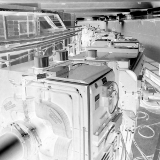Speaker
Dr
Laszlo Liszkay
(IRFU CEA Saclay)
Description
A key step of the GBAR experiment (Gravitational Behaviour of Antihydrogen at Rest) is the production of the positively charged antihydrogen ion. It can be cooled to cryogenic temperature and used for the creation of a cold neutral antihydrogen atom for the direct measurement of the effect of gravitation. The ion will be produced in two steps. The first is the charge exchange reaction between an antiproton and a positronium in a dense positronium cloud, which produces an antihydrogen atom at keV energy. Positive ions are produced in a second reaction, between the anti-atom and a second positronium. We are setting up an experiment to measure the cross section of both reactions. In the first phase, a proton beam will be used to measure the matter equivalent of the reactions, using positronium in 1S, 2P and 3D states. In the second phase antiprotons from the CERN AD/ELENA facility will be used to study the reactions producing antihydrogen atoms and, eventually, positive antihydrogen ions. We will present the experimental setup and discuss the results expected on the basis of theoretical calculations.
Primary author
Dr
Laszlo Liszkay
(IRFU CEA Saclay)




